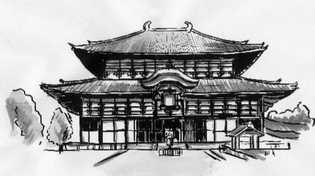国分寺と徭役 - Kokubunji and Yoeki
The Kokubunji Temple idea originated in the 8th century, in the Nara period, as a government institution built on the lines of a similar custom of the T’ang Dynasty in China (618 – 907). In 741, Emperor Shomu decreed that every province build a Kokubunji Temple, as well as a Kokubun-niji Nunnery. These temples and convents were mostly completed by 780 A.D. The most important temple is in Nara – Todaiji – where a 16-meter tall Buddha is enshrined.
国分寺は、奈良時代の8世紀、唐王朝(618〜907)にならって設置された朝廷の機関に端を発します。741年、聖武天皇により、すべての国に国分寺と国文尼寺を建立するようにとの詔が出されました。この事業は780年までにほぼ完了しましたが、その中心であったのが、高さ16メートルもの大仏を安置した奈良の東大寺です。
A convent was usually occupied by about 10 nuns, and a temple usually had about 20 monks. The duty of the temple monks was to pray for the protection of the country. The convent nuns were to pray for the atonement of sin. The buildings were financed by the government and by Uji (rich families). Construction labor was provided by peasants in payment of their taxes, as legalized by the Taika Reform of 645 A.D. Instead of giving material wealth, peasants were forced to perform unpaid labor on government projects during an annual 60-day labor period, made longer when deemed necessary.
各国分寺には約20人の僧が、国文尼寺には約10人の尼僧が住みました。僧は国の安泰を祈ることをその役目とし、尼僧は罪をあがなうために祈りました。 国分寺や国文尼寺を建造する費用は、朝廷や「氏」と呼ばれる豪族たちが拠出しました。そして、実際の作業には農民が駆り出されました。これは、農民に朝廷の事業のために60日の無報酬労働を義務付けるという、大化の改新で新たに決まった労働税によるもので、必要ならばさらに長い日数働くことを強制されました。
Rich people could escape this “work tax” by paying with goods like silk, hemp, cotton, salt or iron. Poor people paid with their sweat. Adult men through age 60 were required to work 60 days; men aged 61 through 65 had to work for 30 days; and youths between the ages of 17 and 20, had to work for only 15 days. The French called this kind of labor, “corvee.”
豪族は絹、麻、綿、塩、鉄といった品物を納めることでこの義務から逃れることができましたが、貧しい農民たちは額に汗を流して働くしかありませんでした。60歳以下の成人は60日、61歳から65歳までの人は30日、17歳から20歳までの若者は15日間働くことを義務付けられました。 このような制度をフランス語で「コービー」と言います。
It was known by many names in Japan, depending on the type of work performed. Yoeki was the work tax, later changed to Buyaku. Koeki was for temple work. Zoyo was for public works, and Saieki meant the 10 days people spent working in the capital. This was the system under which all the most beautiful buildings were constructed in the old days. It sounds very efficient, but I wonder what the people thought of it. s to us!
日本では、仕事の内容によってさまざまな呼び方をしました。労働税は初め、「徭役」と呼ばれていましたが、後に「夫役(ぶやく)」と呼ばれるようになり、寺院の建造は「公役」、公共事業は「雑徭」、都に十日間滞在して働くことは「歳役」と呼ばれました。今も残るこの時代の美しい寺院の多くは、こうした制度の下で建てられたのです。非常に効率的な手法のように思われますが、さて、当時の人々はどのように感じていたでしょうか。
